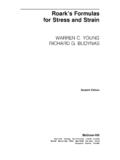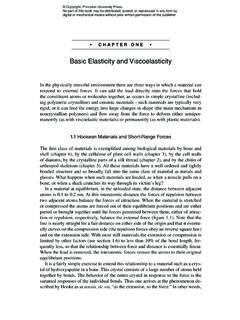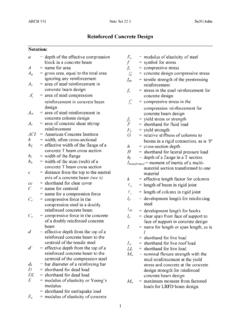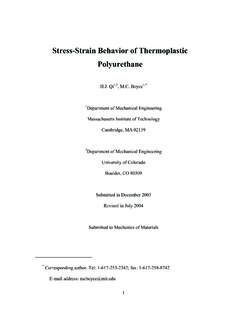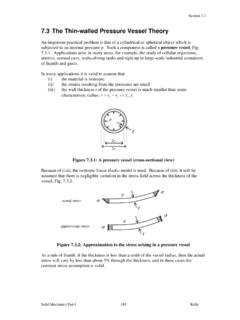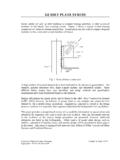Transcription of stress and strain - freestudy.co.uk
1 1 MECHANICAL PRINCIPLES HNC/D PRELIMINARY LEVEL TUTORIAL 1 BASIC STUDIES OF stress AND strain This tutorial is essential for anyone studying the group of tutorials on beams. Essential pre-requisite knowledge for Edexcel HNC Mechanical Principles UNIT 4 outcome 2. Essential pre-requisite knowledge for the Engineering Council Diploma exam D209 Mechanics of Solids. Essential pre-requisite knowledge for the Engineering Council Certificate Exam C105 Mechanical and Structural engineering. Covers part of the syllabus for the Engineering Council Certificate Exam C103 Engineering Science. You should judge your progress by completing the self assessment exercises. These may be sent for marking at a cost (see home page). On completion of this tutorial you should be able to do the following. Define direct stress and strain .
2 Define shear stress and strain . Define the modulus of elasticity and rigidity. Solve basic problems involving stress , strain and modulus. It is assumed that the student is already familiar with the concepts of FORCE. 2 1. DIRECT stress When a force is applied to an elastic body, the body deforms. The way in which the body deforms depends upon the type of force applied to it. A compression force makes the body shorter. Figure 1 A tensile force makes the body longer. Figure 2 Tensile and compressive forces are called DIRECT FORCES. stress is the force per unit area upon which it acts. stress = = Force/Area N/m2 or Pascals. The symbol is called SIGMA NOTE ON UNITS The fundamental unit of stress is 1 N/m2 and this is called a Pascal. This is a small quantity in most fields of engineering so we use the multiples kPa, MPa and GPa.
3 Areas may be calculated in mm2 and units of stress in N/mm2 are quite acceptable. Since 1 N/mm2 converts to 1 000 000 N/m2 then it follows that the N/mm2 is the same as a MPa 3 2. DIRECT strain In each case, a force F produces a deformation x. In engineering we usually change this force into stress and the deformation into strain and we define these as follows. strain is the deformation per unit of the original length strain = = x/L The symbol is called EPSILON strain has no units since it is a ratio of length to length. Most engineering materials do not stretch very much before they become damaged so strain values are very small figures. It is quite normal to change small numbers in to the exponent for of 10-6. Engineers use the abbreviation (micro strain ) to denote this multiple. For example a strain of could be written as 68 x 10-6 but engineers would write 68.
4 Note that when conducting a British Standard tensile test the symbols for original area are So and for Length is Lo. WORKED EXAMPLE A metal wire is mm diameter and 2 m long. A force of 12 N is applied to it and it stretches mm. Assume the material is elastic. Determine the following. i. The stress in the wire . ii. The strain in the wire . SOLUTION 2222N/mm AF mm x 4 dA Answer (i) is hence MPa 150or Lx 4 SELF ASSESSMENT EXERCISE 1. A steel bar is 10 mm diameter and 2 m long. It is stretched with a force of 20 kN and extends by mm. Calculate the stress and strain . (Answers MPa and 100 ) 2. A rod is m long and 5 mm diameter. It is stretched mm by a force of 3 kN. Calculate the stress and strain . (Answers MPa and 120 ) 3. MODULUS OF elasticity E Elastic materials always spring back into shape when released.
5 They also obey HOOKE'S LAW. This is the law of a spring which states that deformation is directly proportional to the force. F/x = stiffness = k N/m Figure 3 The stiffness is different for different materials and different sizes of the material. We may eliminate the size by using stress and strain instead of force and deformation as follows. If F and x refer to direct stress and strain then F = A x = L hence AxFL and L AxF The stiffness is now in terms of stress and strain only and this constant is called the MODULUS of elasticity and it has a symbol E. AxFL E A graph of stress against strain will be a straight line with a gradient of E. The units of E are the same as the units of stress . 5 4. ULTIMATE TENSILE stress If a material is stretched until it breaks, the tensile stress has reached the absolute limit and this stress level is called the ultimate tensile stress .
6 Values for different materials may be found in various sources such as the web site Matweb. WORKED EXAMPLE A steel tensile test specimen has a cross sectional area of 100 mm2 and a gauge length of 50 mm, the gradient of the elastic section is 410 x 103 N/mm. Determine the modulus of elasticity . SOLUTION The gradient gives the ratio F/A = and this may be used to find E. GPa 205or M Pa 000 205or N/mm 000 205 100 50 x 10 x 410 ALxxF E23 WORKED EXAMPLE A Steel column is 3 m long and m diameter. It carries a load of 50 MN. Given that the modulus of elasticity is 200 GPa, calculate the compressive stress and strain and determine how much the column is compressed. SOLUTION mm mm 3000 x xso Lx x10200 so EPa x1050AF m x 4 dA9666222 6 SELF ASSESSMENT EXERCISE 1. A bar is 500 mm long and is stretched to 505 mm with a force of 50 kN.
7 The bar is 10 mm diameter. Calculate the stress and strain . The material has remained within the elastic limit. Determine the modulus of elasticity . (Answers MPa, and GPa. 2. A steel bar is stressed to 280 MPa. The modulus of elasticity is 205 GPa. The bar is 80 mm diameter and 240 mm long. Determine the following. i. The strain . ( ) ii. The force. ( MN) 3. A circular metal column is to support a load of 500 Tonne and it must not compress more than mm. The modulus of elasticity is 210 GPa. the column is 2 m long. Calculate the cross sectional area and the diameter. ( m2 and m) Note 1 Tonne is 1000 kg. 7 5. SHEAR stress Shear force is a force applied sideways on to the material (transversely loaded). This occurs typically: when a pair of shears cuts a material Figure 4 when a material is punched Figure 5 when a beam has a transverse load.)
8 Figure 6 when a pin carries a load. Figure 7 Shear stress is the force per unit area carrying the load. This means the cross sectional area of the material being cut, the beam and pin respectively. Shear stress = F/A The symbol is called Tau 8 The sign convention for shear force and stress is based on how it shears the materials and this is shown below. Figure 8 In order to understand the basic theory of shearing, consider a block of material being deformed sideways as shown. Figure 9 6. SHEAR strain The force causes the material to deform as shown. The shear strain is defined as the ratio of the distance deformed to the height x/L. The end face rotates through an angle . Since this is a very small angle, it is accurate to say the distance x is the length of an arc of radius L and angle so that = x/L It follows that is the shear strain . The symbol is called Gamma.
9 9 7. MODULUS OF RIGIDITY G If we were to conduct an experiment and measure x for various values of F, we would find that if the material is elastic, it behave like a spring and so long as we do not damage the material by using too big a force, the graph of F and x is a straight line as shown. The gradient of the graph is constant so F/x = constant and this is the spring stiffness of the block in N/m. If we divide F by the area A and x by the height L, the relationship is still a constant and we get constantAxFLLxAF Figure 10 But F/A = and x/L = soconstant AxFLLxAF This constant will have a special value for each elastic material and is called the Modulus of Rigidity with symbol G. G 8. ULTIMATE SHEAR stress If a material is sheared beyond a certain limit it becomes permanently distorted and does not spring all the way back to its original shape.
10 The elastic limit has been exceeded. If the material is stressed to the limit so that it parts into two( a guillotine or punch), the ultimate limit has been reached. The ultimate shear stress is u and this value is used to calculate the force needed by shears and punches. WORKED EXAMPLE Calculate the force needed to guillotine a sheet of metal 5 mm thick and m wide given that the ultimate shear stress is 50 MPa. SOLUTION kN 200or N 000 200 4000 x 50A x F so AFN/mm 50 is stressshear ultimate The mm 4000 5 x 800 A mm 5 x mm 800 rectangle a iscut be toarea The22 10 WORKED EXAMPLE Calculate the force needed to punch a hole 30 mm diameter in a sheet of metal 3 mm thick given that the ultimate shear stress is 60 MPa. SOLUTION kN N 16965 x 60A x F so AFN/mm 60 is stressshear ultimate The mm 3 x 30 x A x t d ss x thicknencecircumfere theiscut be toarea The22 WORKED EXAMPLE Calculate the force needed to shear a pin 8 mm diameter given that the ultimate shear stress is 60 MPa.










